World Environment: India’s Concern And Contribution
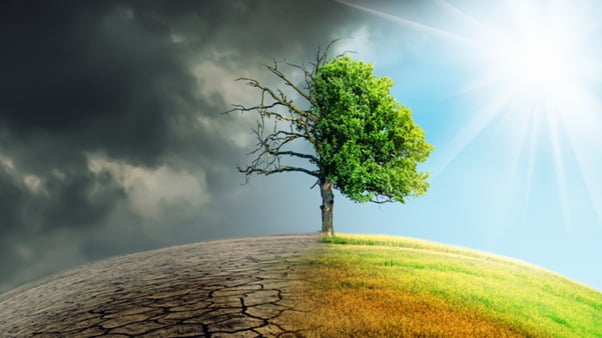
As deliberated in part one of the series, India’s inter-relationship with environment and Nature goes back to the Vedic ages. The progress of India on this front has been timely and fast. Taking initiative from the United Nations Conference on the Human Environment, 1972, India incorporated environmental concerns in the Constitution through the 42nd Amendment in 1976. Environment has become a priority in policy statements, plans and strategies; especially after 1980 with the establishment of a full-fledged Ministry of Environment and Forests. Increasing concern on Environmental Education (EE) in India gained momentum while its importance was recognized by the government and policy was planned. Subsequently in 1985, the Supreme Court ruled that Article 21 of the Constitution, which guarantees each citizen the “right to life,” necessarily includes the “right to a healthy environment”, thereby requiring mandatory environmental education to fulfil the fundamental duties of citizens to “protect and improve the natural environment”. The Indian Institute of Ecology and Environment(IIEE), New Delhi, is at the forefront today to impart education on environment.
Mahatma Gandhi’s seminal work, Hind Swaraj, written in 1909, fore-warned the dangers the world is facing today in the form of environmental destruction and the threat to the planet. His words, “The Earth has enough resources for our need but not for our greed”, became a clarion call for later environmentalists to launch major movements, such as the Chipko movement led by Chandi Prasad Bhatt and Sunder Lal Bahuguna and the Narmada Bachao Andolan by Baba Amte and Medha Patkar, to protect the environment.
Fast tracking to today, let us examine the latest scenario of the environment and India’s perspective.
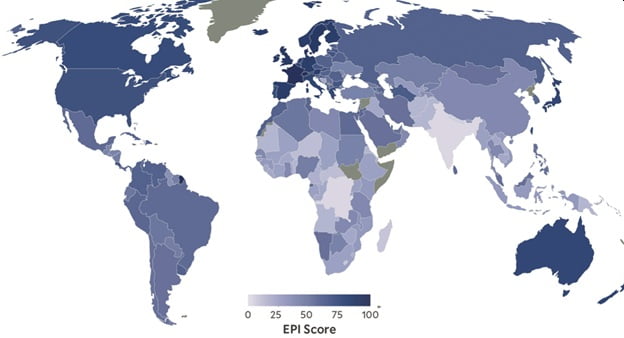
India is among the bottom five countries on the Environmental Performance Index, 2018 (EPI), plummeting 36 points from 141 in 2016, according to a biennial report by Yale and Columbia Universities along with the World Economic Forum.
While India is at the bottom of the list in the environmental health category, it ranks 178 out of 180 as far as air quality is concerned.
Its overall low ranking, 177 among 180 countries, was linked to poor performance in the environment health policy and deaths due to air pollution categories.
The EPI pointed out that deaths attributed to ultra-fine PM2.5 pollutants have risen over the past decade and are estimated at 1,640,113 annually in India.
Most concerning environmental issues according to citizens across India as of March 2019
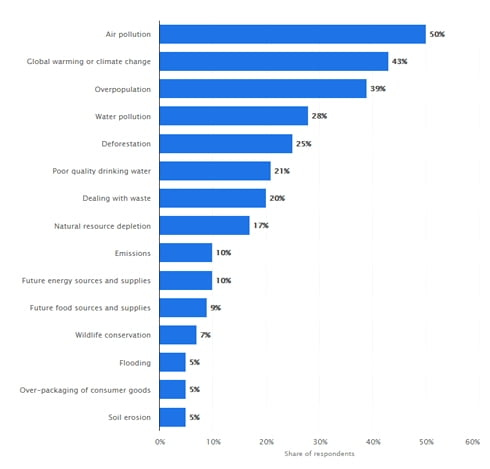
Some India Indices:
- In its report, environment thinktank Centre for Science and Environment’s (CSE) State of India’s Environment (SoE) says that on an average, 8.5 out of every 10,000 children in India die before they turn five; while the risk was higher for girls as 9.6 out of 10,000 girls die before five years of age due to bad air.
- Air pollution is responsible for 12.5 per cent of all deaths in India. Its impact on children is equally worrying, going by the CSE report.
- Over 1,00,000 children below the age of five die due to bad air in the country, said the CSE report.
- India is facing the worst water crisis in its history, and in a new report from the NITI Aayog, a government thinktank, 21 Indian cities will run out of groundwater by 2020, thus highlighting the need for urgent and improved management of water resources.
Major initiatives taken by India towards environment protection:
The first major initiative in the saga of India’s mission for environment protection was the National Action Plan on Climate Change (NAPCC), launched in 2008 by the Prime Minister’s Council on Climate Change. It aimed at creating awareness among the representatives of the public, different agencies of the government, scientists, industry and the communities on the threat posed by climate change and the steps to counter it.
There were 8 national missions forming the core of NAPCC, which represents multi-pronged, long-term and integrated strategies for achieving key goals in climate change. The guiding principles were:
- Protection of poor and vulnerable sections of society through inclusive and sustainable development strategy.
- Achievements of national growth through qualitative changes enhancing ecological sustainability.
- Deployment of appropriate technologies for both adaptation and mitigation of Green House Gases emissions extensively and at an accelerated pace.
Regrettably, India continued to slide in the EPI. There was a perceptible change when Narendra Modi took over as the Prime Minister in 2014 with the launch of many proactive initiatives and also because of the greater awareness and parallel initiatives launched by the world bodies and various countries; with a looming environment crisis taking the international centrestage.
Let us study some of the major initiatives post-2014, taken up by India:
Namami Gange Programme
After taking over as the Prime Minister of India in 2014, in June that year, Narendra Modi,recognising the cultural and environmental importance of the river Ganga, the Namami Gange Programme was approved by the Union government. The Centre allocated Rs 20,000 crore to conserve and rejuvenate the river. It involved the people living on the banks of the river, and helped them attain sustainable livelihoods.
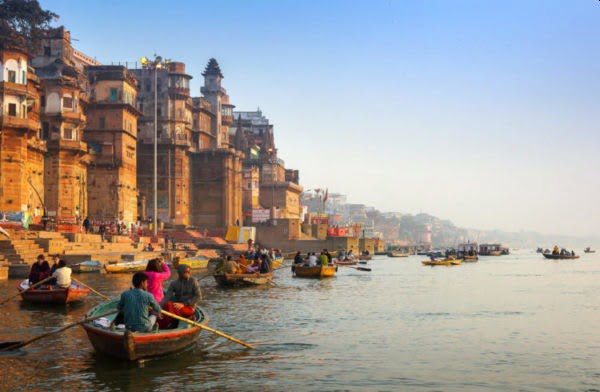
Compensatory Afforestation Fund Act (CAMPA)
The government of India introduced Compensatory Afforestation Fund Act (CAMPA) in 2016. It also established National Compensatory Afforestation Fund and State Compensatory Afforestation Fund the same year. Under this act, any individual or organisation intending to use forest lands for non-forest purposes will be charged.

Green Skill Development Programme
Moving away from technical or industrial skills, the Green Skill Development Programme was launched in June 2017 by the Ministry of Environment, Forest, and Climate Change. ‘Green skills’ refers to those that contribute to preserve and restore environment and create a sustainable future. Hence, the programme focuses on developing skills among the youth in the environment and forest sector.

Swachh Bharat Abhiyan
The national cleanliness drive – Swachh Bharat Abhiyan, is perhaps the most popular campaign relating to environment that the Modi government launched. Earlier, running as a candidate for the Prime Ministership, his clarion call to the youth, ‘Pehle shauchalaya, phir devalaya’ became a popular slogan. Launched on Mahatma Gandhi’s birth anniversary on October 2, 2014, the movement had people coming out to clean the roads across India. Photographs of Modi sweeping the streets became quite a sensation for some time, as he kick-started the first cleanliness drive. It is considered to be the most innovative country-specific environmental drive in the world.
India declared itself “open-defecation free” (ODF) on October 2, 2019, the 150th birth anniversary of Mahatma Gandhi, by constructing over 100 million toilets in rural India.

The International Solar Alliance 2018
This initiative was first proposed by Modi in a speech on November 30, 2015, at Wembley Stadium, in which he referred to sunshine countries as Suryaputra (“Sons of the Sun”), with a special emphasis on India. Taking the initiative further, The International Solar Alliance (ISA) held its founding conference in New Delhi, co-chaired by Modi and French President Emmanuel Macron on March 11, 2018.
The International Solar Alliance is an international organisation with 79 member countries. It works with governments to improve energy access and security around the world and promote solar power as a sustainable way to transition to a carbon neutral future.
For bringing to fruition the innovative and unique International Solar Alliance, Modi was recently granted the UN’s Champions of the Earth Award along with Macron.
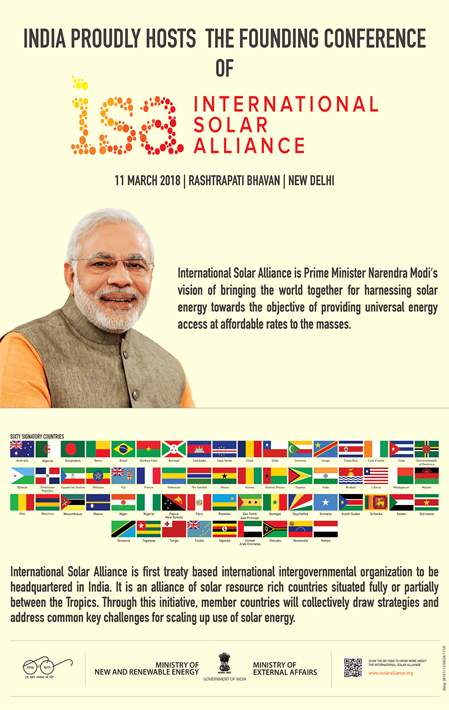
India Cooling Action Plan 2019
One of the major milestones in India’s fight against its poor environmental record was taken on March 8, 2019, when Union Minister for Environment, Forest and Climate Change Harsh Vardhan released the India Cooling Action Plan (ICAP), at a function in New Delhi, the first such initiative in the world. The India Cooling Action Plan seeks to:
- Reduce cooling refrigerant and energy demand across sectors by 20% to 25% by 2037-38.
- Training and certification of 100,000 servicing sector technicians by 2022-23, synergizing with Skill India Mission.
![]()
These actions, besides its significant environmental benefit, will also usher in societal benefits like:
- Doubling farmers’ income, better cold chain infrastructure, better value of produce to farmers, less wastage of produce.
- Skilled workforce for better livelihoods and environmental protection.
- Make in India, domestic manufacturing of air-conditioning and related cooling equipment.
- Robust R&D on alternative cooling technologies to provide push to innovation in cooling sector.
(This is the second part of the three-part series coinciding with World Environment Day)
Also Read: Earth Day Musings Amid COVID Lockdown


Comments are closed.